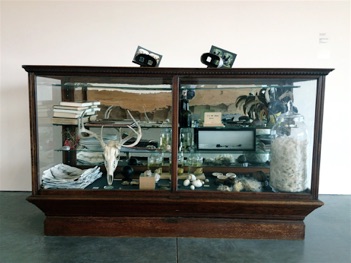Schedule for Observational Findings
Lobby Gallery
November 5 – January 31 Extended thru March 31
Genius Loci: Observational Findings
Observational Findings is framed by Samual L. Parrish’s 19th Century Colonial curio cabinet (Note 1) originally installed (1897) in the Art Museum at Southampton that Parrish founded (1940’s named Parrish Art Museum).
Encompassing objects and documentation selected by Sandrow as symbols of the “Genius Loci” of the Parrish Art Museum - past and present - during transition on this new site. The vitrine’s rotating contents – ranging from rare photographs, including those of William Merritt Chase owned by Sandrow from the earliest days of the Museum to found objects like “good luck” horseshoes and a quartz crystal, and elixir bottles unearthed from the grounds of the artist’s open air studio Shinnecock Hills (Note 2) – serve as reminders of the customs, such as fortune tellers, prevalent at the time in which the curio case was in the Museum founded by Parrish.
And also relate to our time (2012) when the new Parrish Museum is the first structure built here recently used for agriculture; as Shinnecock Indian Nation advocates for respectful recognition of ancestral Algonquin lands. Relating to the issue of gentrification and the role of art institutions and artists: a gallery dedicated to William Merritt Chase’s paintings. Other contemporary found objects relate to the agrarian roots (including a poultry farm) of the new Museum site - including deeds; memorials to local farmer Bradford Reeve and Artist Roy Lichtenstein; materials and processes of observation; and the golden ratio found in both nature and the proportions of the new building’s galleries.
“The prevailing spirit” of the new Parrish Museum’s site reveals a social and cultural Colonial history mirroring that of America all over this land. Including Philadelphia, where Parrish (1849), a Quaker, and Sandrow (1951) were both born. An area first settled by the Lenni-Lenape, also in the Algonquin Family as are Shinnecock, before taken by the first Quaker English settlers who were followers of William Penn who arrived in the late 17th century.
click here for detailed information and close up pictures...
Note 1: Parrish’s cabinet gifted (2012) to Hope Sandrow by Southampton Historical Museum. Sited (since 1952) in the Rogers Mansion that was Samuel L. Parrish’s home in Southampton Village till his death (1932); where Sandrow exhibited (2007) “(Re)Collecting an American’s Dream”.
Note 2: open air studio Shinnecock Hills located in Sandrow’s “backyard” within the Shinnecock Indian Contact Period Village Fort Critical Environmental Area (designated 1988). Ancestral lands amongst those seized (1859) from Shinnecock Indian Nation by the Town of Southampton, managed by Samuel L. Parrish in his role as President of the Long Island Improvement Society. And that he sold privately including acreage (1891) to Jane Borrowe and E. Boudinot Colt : now Sandrow’s “backyard” including the (1906) Gatehouse (Sandrow’s home and studio) attributed to architect Grosvenor Atterbury who Parrish hired to design his Art Museum at Southampton, and (1891) Cottage (update: Sandrow’s studio, 2020) thought to have been the Carriage House to William Merritt Chase before moved to current location

